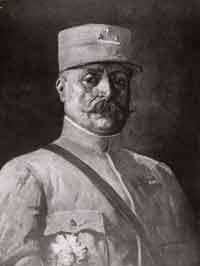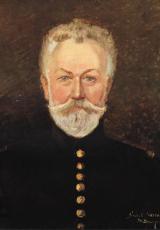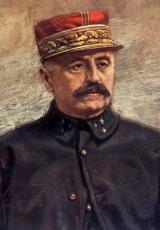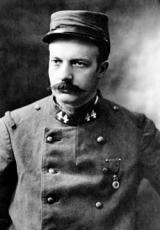Adolphe Guillaumat

Guillaumat, Adolphe Marie Louis (Bourgneuf, Charente-Maritime: 4 January 1863 - Nantes, Loire-Atlantique : 18 May 1940)
Adolphe Guillaumat, the son of Louis Guillaumat, an officer, and Marie Noémie Fleury, entered Saint-Cyr military academy in 1882, graduating with the rank of chief warrant officer on 1 October 1884. He chose to serve in the 65th infantry regiment (R.I.) in Nantes. A captain in 1893, in April 1895 he joined the 2nd foreign infantry regiment and left for Tonkin in September 1897. Guillaumat made his mark by occupying Kwang-Chou-Wan (Guangzhouwan), which China leased to France. During the Boxer Rebellion, under General Voyron's orders he participated in the march on Tien-Tsin (Tianjin) and the fighting on 23 June 1900 led by the international column in front of the city's arsenal, opening up the road to Peking, which it reached on 14 August. Commanding the French garrison, he was wounded during the fighting and in December 1900 promoted to major in recognition of his heroism. Back in France, in 1903 Guillaumat taught military history at Saint-Cyr and in 1905 earned the general staff diploma, the brevet direct. He joined the War College staff in 1906 and married Louise Bibent on 17 July of the same year.
Guillaumat, a professor of infantry tactics, became lieutenant-colonel in 1907 and was appointed commander of the military academy in September 1908. He became a colonel on 28 September 1910, commanding the 5th R.I., and joined the Ministry of War's infantry department in January 1913. On 8 October 1913 Guillaumat became brigadier general, continuing his career at the ministry before being appointed Minister Messimy's chief of staff on 14 June 1914. In September, after the war broke out, Guillaumat joined the 4th Army, taking command of the 33rd infantry division (D.I.), with which he participated in the first Battle of the Marne (6 to 11 September 1914) and the bloody fighting at Vitry-le-François before holding a sector in Champagne. Assigned to the 4th D.I., he temporarily became major-general in December 1914. On 25 February 1915 he was appointed commander of the 1st army corps (C.A.), also called the "Guillaumat Group", which he led at the first Battle of Champagne and the Battle of Woëvre (in April), and with which he held the Champagne sector. His unit fought in the Battle of Verdun in February 1916 before being sent in August to the 6th Army north of the Somme, which backed up the English armies' right flank. On 15 December 1916 Guillaumat received command of the 2nd Army and, at the head of 650,000 men, returned to the Verdun front, stopping the German attacks in spring 1917. On 20 April he stormed the enemy positions, taking the French lines north of Hill 304 and Mort-Homme.
On 14 December 1917 Guillaumat succeeded General Sarrail in the Balkans, becoming commander-in-chief of the Allied armies in the East. To cope with a difficult military situation, he reorganised the Allied forces, restoring trust and discipline in the ranks. Taking advantage of the transfer of enemy troops to the Western front after the Treaties of Brest-Litovsk (3 March 1918) and Bucharest (5 March 1918), he launched the French and Greek troops, breaking with the Superior War Council's defensive strategy aligned with the Anglo-American strategy of holding the line on the Stavros-Monastir front. He implemented a general offensive serving as a basis of operations for his successor, Franchet d'Esperey, and compelled Bulgaria to request an armistice. But his main achievement on the Eastern front was turning the Allied armies, which until his arrival belonged to the French forces' superior general staff, into a tool adapted to the command of a multinational force that proved decisive during the ambitious offensive in September 1918. The second defeat at the Chemin des Dames in May 1918 brought the Germans within 75km of Paris and was the reason for Guillaumat's return to France. Appointed military governor and commander of Paris on 15 June 1918, he convinced the general staff to accept the plan of an offensive on the Eastern front. Once Paris was out of danger, Guillaumat was appointed head of the 5th Army, which he engaged in the second Battle of the Marne, in Champagne and in the Meuse in October-November 1918. Guillaumat received the Grand-Croix of the Légion d'honneur on 10 July 1918 and the military medal on 3 October 1918. He became inspector-general in June 1919, a member of the High War Council in 1920 and commander of the Rhine occupation army on du 11 October 1924. At the same time, he chaired the territory defence commissions from 1922 to 1931. The first, which Minister of War André Maginot created in 1922 to develop a plan to defend France, was replaced by a border defence commission, forerunner of the C.O.R.F. (Fortified Regions Organisation Commission) and the "Maginot Line". Minister of war in the Briand-Caillaux cabinet from 23 June to 20 July 1926, he resumed his command until France evacuated the Rhineland on 30 June 1930. He continued participating in the of the Upper War Council's work until being dismissed on 4 June 1933. Guillaumat, who advocated a rigorous policy, constantly drew politicians' attention to the dangers of German rearmament and the need for France to conduct a military policy: longer national service, construction of defensive works along the border and modernisation of the army.? He retired in Nantes, where he died in 1940. His remains were buried in the "governors' vault" (Hôtel National des Invalides) in November 1947.




